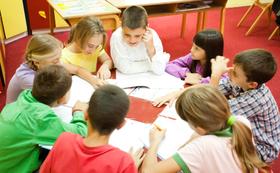Top Rankings
Muscatine Community School District ranks among the top 20% of public school district in Iowa for:
Category
Attribute
Diversity
Most diverse schools (Top 1%)
Community Size
Largest student body (number of students) (Top 1%)
For the 2025-26 school year, there is 1 public middle school serving 599 students in Muscatine Community School District. This district's average middle testing ranking is 2/10, which is in the bottom 50% of public middle schools in Iowa.
Public Middle School in Muscatine Community School District have an average math proficiency score of 62% (versus the Iowa public middle school average of 68%), and reading proficiency score of 60% (versus the 71% statewide average).
Minority enrollment is 41% of the student body (majority Hispanic), which is more than the Iowa public middle school average of 25% (majority Hispanic).
Overview
This School District
This State (IA)
# Schools
9 Schools
376 Schools
# Students
4,421 Students
127,807 Students
# Teachers
320 Teachers
8,868 Teachers
Student-Teacher Ratio
14:1
14:1
Student By Grade
District Rank
Muscatine Community School District, which is ranked within the bottom 50% of all 325 school districts in Iowa (based off of combined math and reading proficiency testing data) for the 2022-2023 school year.
The school district's graduation rate of 83% has decreased from 84% over five school years.
Overall District Rank
#301 out of 327 school districts
(Bottom 50%)
(Bottom 50%)
Math Test Scores (% Proficient)
60%
68%
Reading/Language Arts Test Scores (% Proficient)
59%
70%
Science Test Scores (% Proficient)
57%
63%
Graduation Rate
83%
90%
Students by Ethnicity:
Diversity Score
0.58
0.43
% American Indian
n/a
n/a
% Asian
1%
2%
% Hispanic
30%
11%
% Black
5%
6%
% White
58%
75%
% Hawaiian
n/a
1%
% Two or more races
6%
5%
All Ethnic Groups
District Revenue and Spending
The revenue/student of $15,759 in this school district is less than the state median of $16,468. The school district revenue/student has grown by 5% over four school years.
The school district's spending/student of $13,823 is less than the state median of $16,042. The school district spending/student has grown by 5% over four school years.
Total Revenue
$70 MM
$8,262 MM
Spending
$61 MM
$8,048 MM
Revenue / Student
$15,759
$16,468
Spending / Student
$13,823
$16,042
Best Muscatine Community School District Public Middle Schools (2025-26)
School
(Math and Reading Proficiency)
(Math and Reading Proficiency)
Location
Quick Facts
Rank: #11.
Susan Clark Junior High School
(Math: 62% | Reading: 60%)
Rank:
Rank:
3/
Bottom 50%10
600 Kindler Ave
Muscatine, IA 52761
(563) 263-0411
Muscatine, IA 52761
(563) 263-0411
Gr: 7-8 | 599 students Student-teacher ratio: 12:1 Minority enrollment: 41%
Recent Articles

School Vouchers: Updated Pros and Cons (2025 Review)
Comprehensive 2025 analysis of school vouchers, weighing benefits and challenges for families, funding, outcomes, and policy directions.

Benefits and Drawbacks of Homework in 2025
Explore updated 2025 insights on homework’s benefits, drawbacks, mental health impact, best practices, and policy trends in U.S. public schools.

Charter Schools vs Public Schools 2025: Key Differences & Trends
Explore updated 2025 insights comparing charter schools vs public schools, enrollment, academic outcomes, funding, and real-world examples for families and educators.





